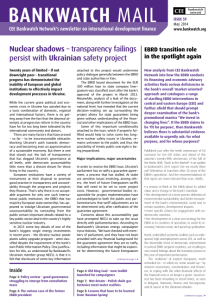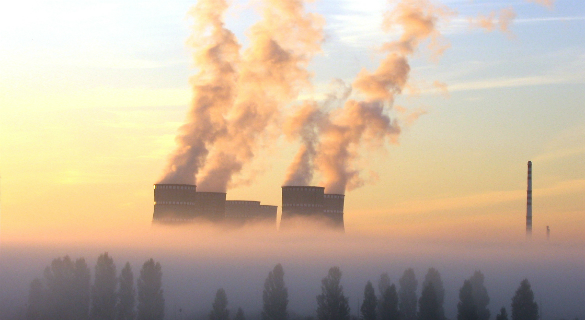Nuclear shadows – transparency failings persist with Ukrainian safety project

Bankwatch Mail | 14 May 2014
Twenty years of limited – if not downright poor – transitional progress has demonstrated the inability of European and global institutions to effectively impact development processes in Ukraine.
This article is from Issue 59 of our quarterly newsletter Bankwatch Mail
Browse all articles on the right
While the current grave political and economic crisis in Ukraine has spiraled due to a toxic combination of domestic, regional and international factors, there is no getting away from the fact that the abysmal attempts at progressive reform in the country have for far too long been tolerated by the international community and donors.
There are many factors that have proved – so far – to be insurmountable obstacles blocking Ukraine’s path towards democracy and becoming even an approximation of a sustainable economy. But there is one that stands out: the lack of transparency that has dogged Ukraine’s governance at all levels, with democratic accountability little more than a distant dream for those living in the country.
European institutions have a variety of instruments at their disposal to promote good practice in transparency and accountability through the programs and projects they finance. That’s why there is no acceptable argument for why one such international public institution, the EBRD that has majority European state ownership, has appeared to indulge Ukrainian governmental unaccountability by concealing from the public certain important details related to a key public sector deal in the country’s highly sensitive nuclear industry.
In 2013 some key details of one of the bank’s biggest single energy investments in recent years – the Ukraine nuclear power plants safety upgrade program – were classified despite the requirement of the bank’s own Public Information Policy. One justification for this, as understood by Bankwatch’s Ukrainian member group NECU, is that it is felt that disclosure of some key information attached to this project would undermine policy dialogue generally between the EBRD and state authorities in Kiev.
At a glance – Ukraine Nuclear Power Plants Safety Upgrade Program
Project timeline:
12 March 2013 – EBRD board decision on project.
25 March 2013 – Signing of the guarantee agreement between the EBRD and Ukrainian Ministry Energy and Coal Industry.
6 November 2013 – Draft law (#0054) on ratification of guarantee agreement submitted to the Ukrainian parliament by then president Viktor Yanukovich.
8 January 2014 – NECU letters sent to members of parliament based on draft law #0054 and financial assumptions derived from leaked EBRD board document.
22 February 2014 – Draft law (#0054) withdrawn from Ukrainian parliament.
25 April 2014 – New draft law (#0082) on ratification of guarantee agreement submitted.
Project essentials:
The EBRD will not disburse a public sector loan unless state guarantees are provided and conditions deemed appropriate to project effectiveness are fulfilled. Guarantees are provided by national legislators ratifying a guarantee agreement.
The EBRD board document for the EUR 300 million loan to state company Energoatom was classified soon after the bank’s approval of the project in March 2013. Meanwhile, analysis of a leak of the document, along with further investigation at the national level, has revealed that the current decision-making set up surrounding the project allows for state guarantees being given without understanding of the financial and other implications of the EBRD loan.
Some of this important conditionality attached to the loan, which if properly fulfilled would help to solve some key long-term nuclear safety issues in Ukraine, remains unknown to the public and thus the possibility of timely public oversight is being jeopardised.
Major implications, major uncertainties
In order to receive the EBRD loan, Ukraine’s parliament has to ratify a guarantee agreement, a process that has stalled. At stake are sensitive issues involving, among others, the level of future Energoatom tariffs that will need to be set to cover project costs. However, governmental bodies responsible for project implementation have acknowledged to both the public and parliamentarians that tariff adjustments are to be determined only after ratification of the guarantee agreement.
Concerns about this accountability gap have prompted NECU to take up the issue directly with parliamentarians. According to Bankwatch’s Ukrainian energy campaigner Iryna Holovko,
“We have checked with members of parliament, and they have not been provided with any financial background for the guarantee agreement they are to ratify, including information that might be expected for determining the future Energoatom tariff level. In fact the responsible governmental bodies are maintaining that the tariff rate required to repay the EBRD loan will only be determined after the national parliament ratifies the guarantee agreement.”
Both the Ministry of Energy and Coal Industry and the National Energy Regulatory Committee, points out Holovko, are equally insisting that “it is not expected to agree the tariff for Energoatom’s electricity with the EBRD”. Thus neither the bank nor the government would appear to know at this stage what the cost-recovery tariff for Energoatom to pay back this loan will be. Although there is thought to be no direct correlation between a rise in the tariff for the national energy producer and a rise in tariffs being passed on to consumers, the general situation, believes Holovko, “is doing nothing to improve the government’s accountability.”
These project uncertainties come on top of the long-held contention by Ukrainian environment groups that this EBRD ‘safety’ loan will enable implementation of the country’s heavily-criticised long-term energy strategy that is dominated by nuclear and coal power.
Analysis from Ukrainian energy campaigners has, in recent years, identified how the planned expansion of Ukraine’s nuclear sector is linked to heavy dependency on Russia. Ukraine would be fully dependent on Russian nuclear fuel, heavily dependent on spent nuclear fuel re-processing and short-term storage, as well as on the technology itself.
All Ukrainian reactors are Soviet-type reactors, and even should Ukraine pursue attempts at diversifying its nuclear fuel sources (a rather risky venture bearing in mind incidents that took place involving Westinghouse fuel assemblies at the South Ukrainian nuclear plant in 2012-2013), Russia would still retain significant leverage over Ukraine’s energy sector as there are no alternatives for spent nuclear fuel-reprocessing as well as key equipment needed for reactor upgrades.
At the same time, some of the conditions attached to the safety loan (as set by the EBRD) are welcome ones – for example, the establishment of a national policy and framework for spent nuclear fuel and radioactive waste management, and the setting up of an independent body to ensure sufficient funding for a decommissioning fund.
Of course key conditions such as these are part of any guarantee agreement and thus are publicly available. Yet by classifying the implementation timings and benchmarks involved in these conditions, the EBRD has placed obstacles in the way of effective public oversight.
The leaked EBRD board document mentioned above revealed that the Ukrainian government is supposed to ring-fence the decommissioning fund from using its reserves for purposes other than the decommissioning of old nuclear units, and a properly established national radioactive waste management policy should have been in place by the end of 2013. These initiatives have not been fulfilled properly to date – no changes in set up of the decommissioning fund have been introduced and the radioactive waste management policy has not been the subject of any substantial improvements.
International obligations still not being met
Ukraine is, furthermore, still some way from fulfilling its obligations under the Energy Community Treaty and under international environmental conventions such as Aarhus and Espoo. At the most basic level, the country remains in non-compliance with these international agreements as a result – principally – of not having set the legislative framework for environmental impact assessment (EIA) in line with the Aarhus Convention and the European Union’s EIA Directive. The draft law to introduce a partially satisfactory EIA framework failed to receive parliamentary assent in March 2014, casting further doubt on any positive resolution happening soon due to an expected protracted legislative process.
EBRD and interim government pressing on
Meanwhile, published evidence suggests that the EBRD is proceeding with the loan for safety upgrades – a renewed procurement notice for the project was published on April 17, and a further draft law on ratification of the loan agreement was submitted to the Ukrainian parliament on April 25. Ukraine’s interim prime minister Arseniy Yatseniuk has also recently stressed the importance of ratifying the loan as soon as possible to secure European funding for the sector.
A complex situation, therefore, and one compounded by the current instability in the country. NECU is calling on the EBRD not to weaken its stand on demanding timely fulfillment of all the project conditionalities. Pressure from a government so focused on speedy investments, with already dismal Ukrainian transparency norms on the slide once again, should be withstood.
Moreover, with rising tariffs set to be imposed on energy consumers in Ukraine via strictures from both Russia and the IMF (and the wider western donor community), the EBRD is urged to be as open as possible about the price sensitivity of this checkered nuclear safety loan. Who will pick up the bill for it in the end?
Theme: Energy & climate | Social & economic impacts
Location: Ukraine
Project: Zombie reactors in Ukraine
Tags: BW Mail 59 | Ukraine | nuclear | transparency
Never miss an update
We expose the risks of international public finance and bring critical updates from the ground. We believe that the billions of public money should work for people and the environment.
STAY INFORMED

